
Curtiss-Wright Cyclone 22 (XR-4090
A 22-Cylinder Radial
by Kimble D. McCutcheon
Published 1 Jan 2013; Revised 12 Dec 2015
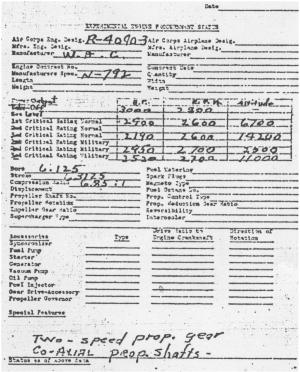 |
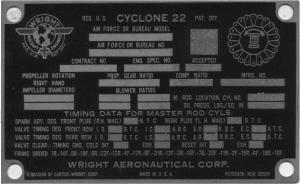 |
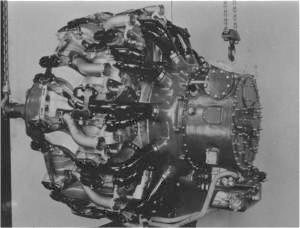 |
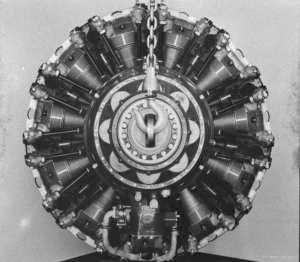 |
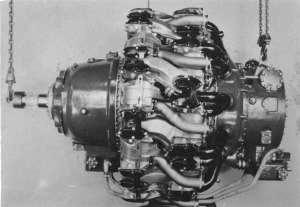 |
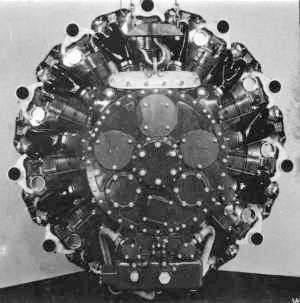 |
| Images Courtesy of the New Jersey Aviation Hall of Fame and Museum | ||
Introduction
The Cyclone 22 (military R-4090), built by the Wright Aeronautical Division or Curtiss-Wright Corporation (hereinafter Wright), is one of the more enigmatic large reciprocating engines of the WWII era. It was one of the few 11-cylinder-per-row radials ever built, and appears to be a design that was hurriedly cobbled together in response to Pratt & Whitney's X-Wasp program that evolved into the Wasp Major (military R-4360). Little information exists on the Cyclone 22, primarily because Wright literally threw it all away as the company exited the aircraft engine business. What remains was pilfered from dumpsters by dedicated employees determined to save the history of the company they loved, or is part of the correspondence between Wright and the U.S. Army Air Corps.
The information that appears in this article comes entirely from primary sources and is organized chronologically. Although it is incomplete, it is my hope that it will provide a basis for further research.
Background
By the middle of 1940, Pratt & Whitney had begun configuration and cooling airflow studies on a 3,000 hp radial engine concept that would eventually become the R-4360. In the fall of that same year, P&W notified the Air Corps that it would abandon the liquid-cooled sleeve-valve engines that had been under development since 1937. These included the 1,800 ~ 2,000 hp H-2600 (also known as the X-1800), upon which the Air Corps had counted upon to power several new aircraft designs. This set in motion a flurry of activity as the Air Corps tried to both identify alternative propulsion to keep its aircraft projects moving forward, and at the same time promote development of engines in the 2,000 ~ 3,000 hp category. One of the things Air Corps did was to contact several engine manufacturers, trying to identify possible alternatives and even hoping another manufacturer could pick up where P&W had left off.
Wright's Response
On 20 Mar 1941, Wright Chief Engineer Raymond W. Young was at the Wright Field answering questions before a group chaired by Power Plant Laboratory Chief Lt. Colonel Edwin R. Page. Col. Page wanted to get information on Wright's plans for larger engines (3,000 hp with potential for 3,500 hp or more) that fell into two broad categories — ones intended to power pursuit aircraft where fuel consumption was a secondary to high output, and ones intended for bombers where maximum economy and reliability were primary considerations. Young thought the later could be achieved with an 18 cylinder air-cooled radial using cylinders with a 7" bore. He envisaged an engine that would be about 55" in diameter, used identical cylinders with forged heads and the exhaust ports of both rows facing in the same direction to achieve additional exhaust thrust for both tractor and pusher installations, feature a two-stage supercharger, offer provisions for two-speed coaxial propellers, and be fuel-injected using two 9-cylinder injection units. Young promised to have the Wright sales division send a general development plan. [28 Mar 1941 Memorandum Report EXP-M-57-503-321. RD2442]
Nearly four months later, on 22 July 1941, Col. Page asked Wright Engineering Vice President Arthur Nutt for some details concerning development of Wright's 3,000 hp engine. Nutt seemed embarrassed that he was unable to discuss the matter, implying that an agreement with the U.S. Navy prevented him from discussing the matter, and "wished the Army and Navy would get together on this project so that he would be free to discuss all details." Col. Page inferred that Wright had already given the Navy a proposal. Nutt explained that since the Army was already interested in the Wright R-2160 Tornado, an engine that was thought to be eventually capable of 3,000 hp, that Wright had assumed the Army would not be interested in a large air-cooled engine. This, of course, was not the case. [23 July 1941 Inter-Office Memorandum. Brig Gen George C Kenney, Assistant Chief, Materiel Division. RD2442]
Army then inquired of Navy the status of the engine project, and it came to light that:
1) Arthur Nutt had suggested the development of a 22-cylinder 3,000 hp air-cooled engine to the Navy on a strictly confidential basis, and had requested that classification himself;
2) No formal development proposal had been received by the Navy Bureau of Aeronautics;
3) The Bureau had no objection to the Air Corps having all available information concerning any proposed development.
[5 Aug 1941 Inter-Office Memorandum from Lt. Colonel B.E. Meyers, Material Division. RD2442]
Without knowing that the Air Corps was talking to the Navy, Nutt perpetuated his subterfuge with a telephone call to his old Power Plant Laboratory friend, Opie Chenoweth, on 11 Aug 1941. Nutt claimed to be curious about a telegram received from the Air Corps requesting a quotation on quantities of one to ten 3,000 hp air-cooled engines, said he had unsuccessfully tried to call Experimental Engineering Chief Lt. Colonel F.O. Carroll, and repeated the story about the 3,000 hp Tornado. Chenoweth told Nutt that he and Col. Carrol, were of the understanding that any large air-cooled engines would be presented to the Air Corps (not the Navy) for first consideration. Nutt stated that a 3,000 hp engine proposal had already been given to the Navy, and that he had suggested to Commander Botta of the Navy Bureau of Aeronautics Engine Design Section a single contract for both Navy and Air Corps needs. [14 Aug 1941 Memorandum Report EXP-M-57-503-420. RD2442]
On 3 Sep 1941 Wright sent Wright Field, via the Air Corps Inspector in Charge at Wright, a booklet of specifications and drawings for its 3,000 hp engine, which it was calling Project X-924. The booklet included Specification #790 describing the engine and its performance when equipped with a single-stage supercharger, Specification #791 describing the engine and its performance when equipped with a two-stage supercharger, and Installation Drawing LS-6981 giving basic engine dimensions. [3 Sep 1941 Letter from Burnham Adams, Manager - Selling Division, Wright Aeronautical Division to the Air Corps Experimental Engineering Section Chief. RD2442]
Raymond Young was back in Dayton on 4 Sep 1941 answering question about Project X-924. He told Aircraft Projects Chief Major L.C. Cragie that Wright had first considered a design with as many known and proven parts as possible. This took the form of an 18-cylinder radial using a new and larger cylinder than the R-3350. However, this approach was abandoned when it became clear that the crankshaft bearing loads would be tremendous. The next iteration was a 22-cylinder radial with cylinders the same 6.125" bore as the R-3350, but with a stroke of 6.375", resulting in a displacement of 4,132 in³. A beefed-up R-3350 nose case and a R-3350-C rear section were to be used. He estimated the dry weight would be about 3,230 lb, and that the engine would have a takeoff rating of 3,000 hp.
Young produced preliminary drawings and opined the engine should be running in about 15 months (Jan 1943). Wright planned an aggressive (and in hindsight, utterly impossible) rollout of five to ten experimental engines, with the first being delivered in Jan 1943, the second in April, third in June, fourth in July, and the balance following at two-month intervals. Young thought that flight engines for experiment pursuit aircraft, complete with two-speed propeller reduction gearing, coaxial rotation, cooling fan and torquemeter, would be available between Mar and Jun 1944 if the Air Corps were to immediately order five to ten X-924 engines.
Young said he was planning a visit the West Coast to discuss Project X-924 with Boeing, Consolidated, Douglas and Lockheed. He hoped these discussions would yield a compromise propeller reduction gear ratio acceptable to the Army, Navy and all their contractors. [5 Sep 1941 Memorandum Report EXP-M-50-588. RD2442]
Young also met with Col. Page and Opie Chenoweth of the Power Plant Laboratory. He told them that the engine would be 58" in diameter, that the single-stage supercharger version (Spec #790) would be 92" long, and that the two-stage version (Spec # 791) would be 108.5" long and weigh 3,445 lb. The engine was to have rear-racing exhausts, all cylinders were to be interchangeable, and Scintilla low-tension ignition was to be used; Young believed this would be adequate up to 40,000 ft. Young also stated that the engine would have adequate scavenging for high altitude operation, probably in response to R-1820 scavenging problems that B-17s operating at high altitude had encountered.
Young further explained propeller reduction gear plans, with two versions envisioned. The first, essentially a beefed-up R-3350, was to have a 0.350:1 ratio, a torquemeter, but no cooling fan drive. The second was a universal gear case that would permit varying gearsets to be installed, feature ratios from 0.25:1 to 0.50:1, have a cooling fan drive, and be capable of coaxial and two-speed operation. Naturally, the later option would require development.
Chenoweth suggested that Wright prepare a specification for an engine with a single-rotation 0.35:1 propeller reduction gear and two-speed supercharger and submit a proposal for one to five engines by 11 September. Col. Page explained that a conference with Navy was being planned where this engine would be discussed. [8 Sep 1941 Memorandum Report EXP-M-57-503-438. RD2442]
On 8 Sep 1941 Col. Page recommended a "Confidential" security classification be applied. Col. Carroll approved his recommendation on 10 Sep and assigned Project Number MX-153 titled "Wright 3000 H.P. Air-Cooled Engine" [8 Sep 1941 Inter-Office Memorandum. RD2442]
During a 26 Nov 1941 conference at Wright Field, Wright revealed that while fuel injection for the R-3350 would consist of two 9-piston pumps, the single X-924 fuel injection pump would consist of 22 pistons. In view of the fact that all X-924 engine were to be purchased through the Air Corps, Arthur Nutt was to submit a new proposal on an engine with two-speed supercharger that could be used with an external turbosupercharger and another with a two-stage, two-speed supercharger. Nutt went on to report that Wright was having trouble obtaining X-924 crankcases because their size dictated they be welded rather than forged.[6 Dec 1941 Memorandum Report EXP-M-57-503-498. P152659]
From early December 1941 through the Army and Navy, along with aircraft, engine and propeller manufacturers who contemplated using or building high power aircraft propulsion systems were involved in a series of meetings and data exchanges aimed at defining shaft specifications for large engine and propellers. These included provisions for large single-rotation and contra-rotating propellers, and engine cooling fans. It was upon this activity that Wright based its choice of an SAE No. 60 spline shaft for its single-rotation engines and SAE Nos. 60 and 80 for contra-rotating versions. Interestingly, Col. Carroll overrode the advice of the Propeller Laboratory on this issue. The propeller laboratory had fought for an SAE No. 70 shaft for single-rotation applications, but Col. Carroll decided that the 60 and 60/80 combination would be used for both the XR-4090 and XR-4360. This highly interesting propeller standardization process will be the subject of a future article in the AEHS web site Propeller section.
Around 8 Dec 1941, Lt. Col. Carroll began thinking about aircraft that would be suitable for flight testing of the 3,000 hp-class engines it had in the pipe. On 1 Jan 1942, Col. Page responded that that Wright desired a Vultee Vengeance dive bomber for flight test work. Although there is no record that the XR-4090 was ever flight tested, it is noteworthy that Pratt & Whitney chose this same aircraft type for flight testing its XR-4360. [8 Dec 1941 Inter-Office Memorandum to Chief, Power Plant Laboratory from Chief, Experimental Engineering Section. RD2442]
The Army and Navy had agreed that Army would handle any Navy procurement of X-924 engines. On 1 Dec 1941, the Navy Bureau of Aeronautics Chief wrote the Army Materiel Division requesting Army to start negotiations with Wright for X-924 engines. This set the Army procurement process in motion. [3 Dec 1941 Confidential Technical Instruction CTI-405. RD2442] The Air Corps Contract Section Chief asked the Experimental Engineering Section Chief to request a formal quotation from Wright, which would then lead to Authority for Purchase. As it turned out, the Power Plant Laboratory already had a new Wright Specification No. N-792 that contained information on power and fuel consumption. [11 Dec 1941 Memorandum. RD2442]
On 1 Jan 1942 Power Plant Laboratory Chief Col. Page wrote Experimental Engineering Chief Lt. Colonel Carroll complaining that the numerous project titles (C-22, Wright X-924, Wright 3000 and Wright XR-4090) for Project MX-153 had become confusing, and that some related material was classified while other was not. Col. Page requested that since the engine had been designated XR-4090 and Project MX-153 was already established, that all related material be classified "Confidential" and that the Project MX-153 title be changed to "Wright XR-4090 Engine". This took effect on 3 Jan 1942. [1 Jan 1942 Inter-Office Memorandum. RD2442] It is noteworthy that this is the first mention of a 4,090 in³ displacement in available records, which means that at some point during the last quarter of 1941, Wright changed the stroke from 6.375" to 6.3125", same as the R-3350. This resulted in a calculated displacement of 4,091.9 in³.
Navy Commander Sheldon B. Spangler reviewed Wright Specification N-792 and wrote the following comments:
1) Since the Bureau of Aeronautics had insufficient data to judge whether an SAE No. 60 propeller shaft was large enough for satisfactory single-rotation applications, it wanted Wright to guarantee it would change to an SAE No. 70 shaft if the No. 60 was inadequate for 4-bladed propellers up to 18 feet in diameter and weighing up to 1,200 lb;
2) Any propeller reduction gear ratio that was satisfactory to the Air Corps would be satisfactory to the Navy;
3) The oil pressure pump had to function properly when its inlet pressure is not more than 5 inHg below atmospheric when using grade 1110 oil at 70°C (this same requirement was placed on the XR-4360);
4) Permissible speed range for the high-speed generator drives should be changed to 7,500 ~ 8,600 rpm.
A telegram from Col. Carroll apparently reports on results of negotiations with Wright. The Air Corps had requested bids on the following:
• one 792C22AA1 (XR-4090-1 for the Air Corps)
• two 792C22AA1 (one XR-4090-1 for the Air Corps and one XR-4090-2 for the Navy)
• three 792C22AA1 with coaxial propeller shafts and two-speed propeller reduction (XR-4090-3 for the Air Corps)
Wright had refused to bid on any engines except those single-rotation, single-speed supercharger engines (Specification #790) originally discussed; all other bids would be separate and done at a later date. The Air Corps revised the bid request as follows:
• one 790C22AA1 (XR-4090-1 for the Air Corps)
• three 790C22AA1 (two XR-4090-1 for the Air Corps and one XR-4090-2 for the Navy)
The Navy was asked for comments, but there are none in the file. [23 Apr 1942 Telegram EXP-T-7248 from Col. Carroll to Engineering Section. RD2442]
Wright requested and received permission to furnish Eisemann Magneto Company information and data to assist in design of a new ignition system for the XR-4090. [16 Jun 1942 and 18 Jun 1942 Telegrams. RD2442]
An Air Corps summary of experimental engines under development dated 29 Jul 1942 shows four XR-4090 engines under contract W-535-AC-30116, Authority for Purchase 224908. The first of these (a XR-4090-1 for Air Corps) was slated for delivery on 1 Aug 1942. The Navy XR-4090-2 was to be delivered on 15 Oct 1942; the two remaining XR-4090-1 Air Corps engines were to be delivered on 15 Nov 1943 and 1 Jan 1944. A total of $757,000 was allocated for this purchase, of which the Navy paid $141,500 for its XR-4090-2. [Experimental Aircraft Engines, D1-a, 1941-1946. NMUSAF Archives]
On 13 and 14 Aug 1942 Wright representatives Allan Chilton, H.C. Hill and Raymond Young exhibited layouts and models of cooling fans for R-3350 and XR-4090 series engines. Both cooling fans were of the axial-flow type with moveable vanes ahead of the fan to control cooling and were to be mounted on the engine nose sections. They were designed for operation between 30,000 and 40,000 ft with the vanes wide open; at lower altitudes the vanes closed to prevent excessive power absorption. The R-3350 version controlled the vanes using pulleys and cables while the XR-4090 version used an elaborate set of bevel gears. [28 Aug 1942 Memorandum Report EXP-M-57-503-700. RD2442].
Col. Carroll requested a XR-4090 mockup for temporary display purposes, but Wright Aero replied that there was only one partial completed XR-4090 mockup that was being used for test equipment fitting and was not suitable for display. [28 and 29 Sep 1942 Telegrams. RD2442]
Conclusion
As can be seen from the above timelines, the Cyclone 22 was behind schedule at the end of 1942. There is no reason to imagine the picture ever improved. Wright, whose management and engineering teams were always shallow, was overwhelmed with the events of WWII. Between R-3350 development problems and the difficulties involved with ramping up production to meet war demands, a number of experimental projects languished; the Cyclone 22 was probably among them. I have found no indication that any aircraft manufacturer ever considered the Cyclone 22 to power a design.
At least one XR-4090 was delivered. An XR-4090-1 appears in a U.S. Air Force Museum engine inventory compiled by Robert Casari in 1958; that engine is no longer there, nor is it among the National Air and Space Museum collection, where a number of other engines from that inventory now reside. Like the Chrysler XI-2220-11 at the Walter P. Chrysler Museum and Wright XR-2160-3 at the New Jersey Hall of Fame and Museum, it was probably scrapped during one of the U.S. Air Force Museum's 1960-era house cleanings. Sadly, unlike the XI-2220 and XR-2160, the XR-4090 does not appear to have been rescued from the scrap yard by Walter Soplata.
I am hopeful that additional primary information on the Cyclone 22 will be discovered. The Arthur Nutt paper collection at the National Air and Space Museum Archives is a candidate, as is the collection of Curtiss-Wright material at the New Jersey Aviation Hall of Fame and Museum.
References Key
The following references are from the U.S. National Archives at College Park, Maryland
RD2442 = Record Group 342, RD Number 2442. The RD (Research and Development?) numbering is peculiar to this record group.
P152659 = Record Group 342, Finding Aid UD, Entry 1002-A, Box 5, Power Plant Laboratory Microfilmed Memorandum Reports Reel 15, Frame 2659.